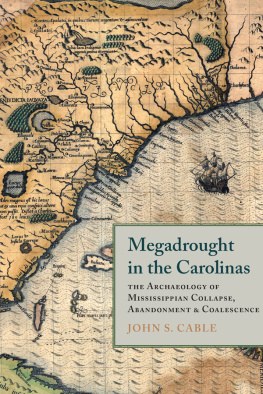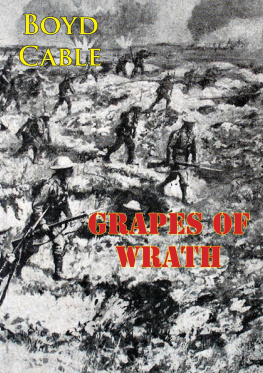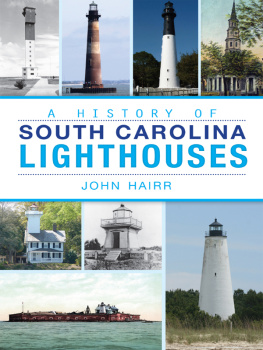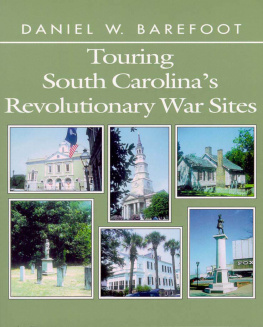Cable John S. - Megadrought in the Carolinas
Here you can read online Cable John S. - Megadrought in the Carolinas full text of the book (entire story) in english for free. Download pdf and epub, get meaning, cover and reviews about this ebook. publisher: University of Alabama Press, genre: Home and family. Description of the work, (preface) as well as reviews are available. Best literature library LitArk.com created for fans of good reading and offers a wide selection of genres:
Romance novel
Science fiction
Adventure
Detective
Science
History
Home and family
Prose
Art
Politics
Computer
Non-fiction
Religion
Business
Children
Humor
Choose a favorite category and find really read worthwhile books. Enjoy immersion in the world of imagination, feel the emotions of the characters or learn something new for yourself, make an fascinating discovery.
- Book:Megadrought in the Carolinas
- Author:
- Publisher:University of Alabama Press
- Genre:
- Rating:5 / 5
- Favourites:Add to favourites
- Your mark:
- 100
- 1
- 2
- 3
- 4
- 5
Megadrought in the Carolinas: summary, description and annotation
We offer to read an annotation, description, summary or preface (depends on what the author of the book "Megadrought in the Carolinas" wrote himself). If you haven't found the necessary information about the book — write in the comments, we will try to find it.
Megadrought in the Carolinas — read online for free the complete book (whole text) full work
Below is the text of the book, divided by pages. System saving the place of the last page read, allows you to conveniently read the book "Megadrought in the Carolinas" online for free, without having to search again every time where you left off. Put a bookmark, and you can go to the page where you finished reading at any time.
Font size:
Interval:
Bookmark:

| ADT | Agricultural Demographic Transition |
| AMO | Atlantic Multidecadal Oscillation |
| AMS | Accelerator Mass Spectrometry |
| BR | Brainerd-Robinson |
| ENSO | El NioSouthern Oscillation |
| GDO | Greater Desert of Ocute |
| INSF | Inferred Nuclear Sherd Family |
| MCA | Medieval Climatic Anomaly |
| PDO | Pacific Decadal Oscillation |
| PDSI | Palmer Drought Severity Index |
| RDR | Ring of Drought Resilience |
| SAM | South Appalachian Mississippian |
| SSA | Seriated Subassembleges |
| SST | Sea Surface Temperature |
| TU | test units |
A project built over decades could not have been accomplished without the contributions of many people too numerous to thank for their individual efforts. Here I will acknowledge those who have had the most direct impact on the final product. First, I thank the reviewers of the various renditions of this manuscript, including Charlie Cobb, Chris Rodning, and Michael Trinkley. Their suggestions and advice were particularly instrumental in improving the presentation of the arguments and inferences made; I am especially grateful to Charlie Cobb for his important feedback throughout the process of writing and rewriting. Wendi Schnaufer of the University of Alabama Press is to be thanked for guiding me through the publication process and offering advice on how to present the subject matter. My copy editor, Irina du Quenoy, is to be thanked for expertly improving the flow of the text and ensuring a clearer presentation of the ideas and arguments offered herein. I benefitted from discussions with my longtime friend and colleague, Chester DePratter, who commented on certain aspects of the book and delivered his thoughts to me in the form of one of his signature three-ring binder notebooks, a treasure I will curate and always appreciate in my personal library. I would like to thank Steve Davis for steadfastly and earnestly responding to my many queries about late prehistory in North Carolina and granting me early access to the digital archive housed at the Research Laboratories of Archaeology. Others who made important contributions include, in no particular order, Joe Herbert, Chuck Cantley, Brett Riggs, Mark Williams, Gary Huckleberry, Gail Wagner, Chris Judge, Greg McCabe, Jeffery Clark, and Brett Hill. I would also like to acknowledge the support of the many individuals who sweated out the fieldwork with me in the swamps and remote areas of Francis Marion National Forest. In particular, the efforts of George Price, Ray Talley, Ken Pinson, Jason Smith, and Sean Taylor will always be appreciated andfondly remembered. Thanks are extended to Chris Judge and Gail Wagner as well for providing me the opportunity to work on three wondrous and magnificent sites in the Wateree Valley. A special note of gratitude is extended to my friend Bob Morgan of the United States Forest Service for his sponsorship and encouragement of my effort to understand regional abandonments in South Carolina. I am grateful to my son Patrick for contributing most of his free summer months while in college to help manage my collections and databases. Finally, I would like to thank my wife, Nita, whose loving support ensured that my project came to fruition.
At the Margins of South Appalachian Mississippian Interaction
As we move in space from the center of the areawhich, it may be noted, is not of necessity the geographical centerand extraneous cultural elements begin to intrude, we shall come at length to a place where the culture, for the ethnologist, is what may be called weak.
Melville Herskovits, A Preliminary Consideration of the Culture Areas of Africa, 1924
Anthropologist Melville Herskovitss stand against heterogeneous and poorly integrated cultural expressions comes across as somewhat prejudiced, but I do not believe that he intended to cast geographic patterns of culture in a negative light. He was attempting to explain the divergent characteristics of cultures situated at the interfaces between typical cultures and those with vivid and extensive cultural expressions. Kopytoff (1987:5) recognized the same phenomenon when he described the groups situated along the frontier interstices between dominant sub-Saharan cultures in Africa as not quite formed societies. What he meant by this description was that these interstices were populated by multicultural groups with diverse ethnic backgrounds that came together to form societies with new institutions and adaptations that differed in significant ways from their various parent communities. The Mississippian settlement of the Central Coast was in many ways just such an intermediate cultural expression.It was a new society, forming late in the process of Mississippianization and attempting to adapt the basic tenets of South Appalachian Mississippianism to an environment that was poorly suited for intensive corn agriculture, the prime mover of SAMs chiefdom tribute systems and demographic expansion. The abandonment of the region in the middle of the fifteenth century cut short the experiment. I show in the chapters to come that this event was not limited to the Central Coast but extended to a much larger area of the Georgia and South Carolina Coastal Plain, most likely as a consequence of megadrought. In this chapter, I present an overview of the Mississippian occupation of the Central Coast to set the stage for a better understanding of the broader implications of this event.
By far, the microenvironment most intensively exploited by Mississippian populations on the Central Coast was the tidal creek mouths of Bulls Bay and Cape Romain (). The creek mouths have been investigated over a span of 24 km and extensive Mississippian occupations have been documented from as far north as Jeremy Creek at McClellanville, South Carolina, to the northern end of Sewee Bay at Andersonville. Southward, the creek mouths are submerged below sea level and this probably served as both an environmental and cultural boundary, effectively separating the groups around Bulls Bay from contemporaneous formations to the south along Copahee Bay, Hamlin Sound, and Mount Pleasant, South Carolina.
The Bulls Bay estuary was a major focus of Mississippian subsistence strategies. The shell middens that demarcate the settlements are not highly mounded, ranging between 25 cm and 80 cm in thickness, but they are horizontally extensive. None of the site clusters have received the kind of broadscale excavation that would expose house patterns, but when similar middens have been peeled away along tidal creek mouths in Beaufort, South Carolina (Mozingo et al. 2004), Georgia (Keene 2004; Pearson 1984), and North Carolina (Millis 2011), ample evidence of domestic structures has emerged. The contemporary Broad Reach site in Carteret County, North Carolina, although not Mississippian in affiliation, is particularly informative. Here, 9 acres of topsoil and shell midden were stripped away, exposing 22,265 postholes and over 100 house plans, numerous human and dog burials, and a wide range of pit types (Millis 2011:6-2). The late prehistoric shell middens along Bulls Bay are of comparable extent and likely contain similar configurations of residential features. Tibwin Creek supports two of the most intensively shovel-tested Bulls Bay clusters. Three major residential sectors have been defined in the North Tibwin tract (Cable 2002a), which together encompass 14.5 acres. The South Tibwin tract has been subjected to two intensive surveys (Brockington and Associates 2011; Cable et al. 1994) and limited test excavations (Cable et al. 2005). The two mainclusters there cover 11.6 acres. Smaller clusters across both tracts add an additional 2.9 acres of either residential space or special activity area. Similar aggregations occur across each of the tidal creek mouths.
Font size:
Interval:
Bookmark:
Similar books «Megadrought in the Carolinas»
Look at similar books to Megadrought in the Carolinas. We have selected literature similar in name and meaning in the hope of providing readers with more options to find new, interesting, not yet read works.
Discussion, reviews of the book Megadrought in the Carolinas and just readers' own opinions. Leave your comments, write what you think about the work, its meaning or the main characters. Specify what exactly you liked and what you didn't like, and why you think so.











